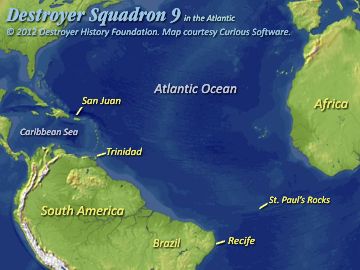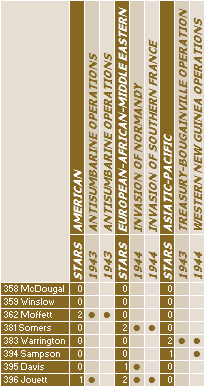

DesRon 9 in the Atlantic.
Five of them, Balch, Clark, Phelps, Porter and Selfridge, were assigned as squadron flagships. The other eight, Davis, Jouett, McDougal, Moffett, Sampson, Somers, Warrington and Winslow, formed Destroyer Squadron 9 in 1937.
After operating with the Pacific Fleet, the squadron moved to the Atlantic following Hitler’s declaration in March 1941 that Iceland was part of the war zone. From June, with Somers as flagship, it was attached to Rear Admiral Jonas Ingraham’s Task Force 3 with Cruiser Division 2—four-stack cruisers Memphis (flag), Milwaukee, Cincinnati and Omaha—operating from Trinidad and Brazilian ports in the Neutrality Patrol, and continuing in anti-submarine patrol and escort duty in the Caribbean Sea and the Central Atlantic after the United States joined the war. In January 1942, Sampson and Warrington were transferred to the Pacific Fleet.

View more maps . . .
In August 1941, DesDiv 17 went north to escort Atlantic Fleet flagship Augusta (CA 31) with President Franklin Roosevelt embarked to Placentia Bay, Newfoundland, where he and Prime Minister Winston Churchill formulated the Atlantic Charter, which affirmed that both Britain and the United States advocated the restoration of self-government to peoples forcibly deprived of it.
Despite operating over great distances, the squadron achieved some success in intercepting blockade runners:
Destroyer Squadron 9
World War II Operations 
Squadron ships also accounted for two German submarines:
The squadron was disbanded in the summer of 1944 soon after the ships of DesDiv 18 (less Warrington, which was still in the Pacific) headed north for the invasion of Normandy on 6 June. On the 21st, Davis was damaged by an explosion, probably from a mine, but Somers and Jouett continued on to the Mediterranean and operated in the invasion of southern France.
Meanwhile, Sampson, Warrington and the four surviving Porters that had served as flagships in the Pacific were withdrawn from the Pacific. First was Clark, which had arrived at Balboa in December 1942 and patrolled off South America’s west coast as flagship of the Southeast Pacific Force until August 1944. The others also passed through the Panama Canal that summer—Sampson in June, Warrington and Balch in July, Phelps in August and Selfridge in September.
In the Atlantic, they commenced escorting convoys to North Africa or Europe and remained in that service until May or June 1945. The exception was Warrington which, while escorting Hyades (AF 28) from Norfolk to Trinidad on 13 September 1944, was overwhelmed by a hurricane and lost with nearly 80 per cent of her crew.
All the 1,850-tonners were retired and scrapped by the end of 1947 except two:
Source: Naval History & Heritage Command including Dictionary of American Naval Fighting Ships histories for individual ships.